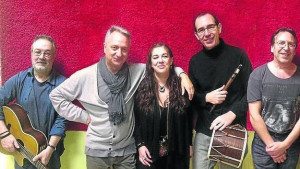 These four CDs represent a good sampling of the recorded output from this talented Castilian Spanish folk ensemble. The other three CDs they’ve done over the years (La Musgaña, 1988; El Paso de la Estantigua, 1989; and El Diablo Cojuelo, 1992) are not readily available in the US at prices most folks (including us) would want to pay. Maybe someday someone will decide to re-release them.
These four CDs represent a good sampling of the recorded output from this talented Castilian Spanish folk ensemble. The other three CDs they’ve done over the years (La Musgaña, 1988; El Paso de la Estantigua, 1989; and El Diablo Cojuelo, 1992) are not readily available in the US at prices most folks (including us) would want to pay. Maybe someday someone will decide to re-release them.
In one configuration or another, La Musgaña has been in existence since 1986. Of the founding members Enrique (also known as Quique) Almendros, Jose Marti Climent and Rafa Martin, only Almendros is still performing with the group. Across these four CDs, the core membership ranges from five (Almendros, Carlos Beceiro, Luis Delgado, Jaime Munoz and Cuco Perez) on Lubicán to three (Almendros, Beceiro and Munoz) on En Concierto and Temas Profanos. Numerous guest artists add to the rich and complex sound experience that characterizes the group’s entire repertory.
Although the music is primarily Castilian Spanish, the band’s official website notes that the central Iberian region has experienced cultural influences from other parts of Europe, Africa, the Mediterranean and the Atlantic. The companies that have distributed each of these CDs point to Celtic influences in the music. All these possibilities are implicit in the instrumental line-up, which includes flute and tabor (frame drum), bagpipes and hurdy-gurdy, cittern, bouzouki, clarinet, accordion and soprano saxophone, along with violin, darbouka, talking drum, oud and Spanish guitar. Typically, each CD also includes a few songs in Castilian Spanish, sung by guest artists.
Lubicán features 14 tracks and runs 52 minutes long. Unfortunately the liner notes are all in Spanish so I can’t say a whole lot about the pieces other than to comment on the artist line-ups, which suggest that most of these are instrumentals. In fact, I only see credits for vocals on four of these.
Las Seis Tentaciones (The Six Temptations) offers 13 tracks with a total run time of just over 48 minutes. The liner notes in this CD, while brief, at least include some text in English, enabling those of us who don’t read Spanish to learn a bit more about the music. Many of these tunes are intended to accompany dances with wonderful names like pica, charro, seguidilla, fandango and mudanza. A few tracks are actually medleys, a practice of blending multiple tunes that should be familiar to anyone who regularly listens to traditional Celtic music.
With 11 tracks recorded at a 1997 concert in Madrid, La Musgaña En Concierto provides just over an hour of high-quality listening. This CD is accompanied by a booklet of liner notes providing brief descriptions of the pieces in English and Spanish, lists of performers for each track (this CD features 10 guest artists) and English translations of lyrics for the four songs. Celtic music fans will appreciate the appearance of the late Johnny Cunningham on three tracks. Johnny also was the CD’s producer.
La Musgaña’s most recent release, Temas Profanos (Profane Subjects), features the three core members along with eight guest artists, including two male and two female vocalists. This CD is a great package, with a whopping 15 tracks, totaling 66 minutes of music. The liner notes, all in English, provide relatively long descriptions of each piece, but no lyrics or lineup details.
As I was writing this review, I treated myself by re-listening to all these CDs. They are a delight to the ear, with sparkling production and lively music. What I find remarkable is how consistent the sound is, regardless of the time in which the music was recorded, the mix of musicians and instruments, or the respective producers. Take your pick, really!
(Lady Alicia, 1991)
(Green Linnet, 1995)
(Resistencia, 1997)
(Mad River, 2007)
